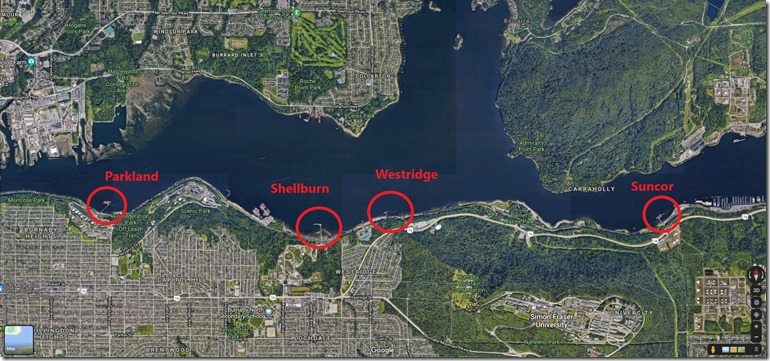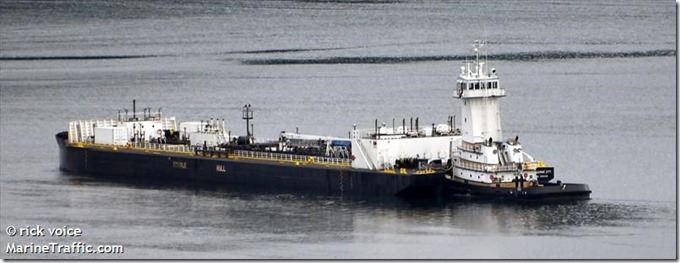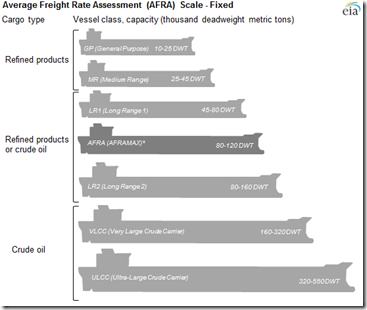With all the talk and interest around the Trans Mountain Pipeline Expansion I became very interested Tanker traffic in the port of Vancouver both to understand the environmentalists claims and the petroleum industries claims of access to world markets, both of which are full of udder lies. I hope the following information helps you to track for yourself tanker traffic in and out of Vancouver so you can see how little crude Canada exports to world markets and also how little tanker traffic there is in Vancouver compared to say Bulk Carriers hauling coal to China from Vancouver and that most tankers coming into Vancouver are here for other things then petroleum (canola oil for example).
First the petroleum layout of the port of Vancouver. Once upon a time Vancouver used to be a major refinery hub and was home to four refineries (and there was a refinery in Kamloops), but now all of those have closed and become product terminals (tank farms for holding product refined elsewhere) other than the smallest refinery, Parkland Burnaby Refinery Burnaby Refinery – Wikipedia NOTE all of these have a connection to the Trans Mountain Pipeline. In the last few years that I have been watching traffic in the port of Vancouver there has never been a tanker or barge carrying petroleum at the IOCO terminal as it is pretty much completely closed down. So the only facilities we need to concentrate on for tracking petroleum in Vancouver are the Parkland Terminal, Shellburn, Westridge, and Suncor terminals.

Westridge Marine Terminal
This is the famed end of the line for the Trans Mountain Pipeline and is to be expanded to be able to handle roughly 34 tankers a month, but I have no idea why as 2 or 3 tankers in a month qualifies as a busy month for this terminal. There are typically two types of tankers that visit this terminal, the first of course is coming to load crude for export to world markets , and the second is coming into Vancouver loaded with aviation fuel (typically from Korea) to unload at the Westridge Marine Terminal. In 2019 more tankers unloaded aviation fuel then loaded crude at the Westridge Marine Terminal. So when you see a tanker coming into the Westridge Marine Terminal you need to note the draught (how deep the tanker is running in the water) to tell if it is loaded or unloaded (NOTE I use Marine Traffic MarineTraffic: Global Ship Tracking Intelligence | AIS Marine Traffic to track shipping in real time in the port of Vancouver, there are other similar sites but this one seems to work the best for Vancouver).

Product Terminals (Parkland, Shellburn, Suncor)
These terminals deal in refined product only, so crude is neither loaded or unloaded at product terminals. Typically refined product from the US, usually from refineries in Washington state is unloaded at product terminals from Articulated Barges pushed by tugs like the One Cure, but these are pretty much a constant parade of different articulated barges as Vancouver imports more petroleum then it exports Port of Vancouver 2018 Statistics Overview (portvancouver.com) NOTE in the report exported refined product includes product sent to Vancouver Island on articulated barges from Vancouver as Vancouver Island gets all its petroleum from Vancouver.

There are also tankers that arrive from the gulf coast of the US like the Port of Good Hope near New Orleans which bring in refined petroleum to Vancouver (traversing the Panama Canal to get to Vancouver).
In 2020 we have noticed an increase in the export of Fuel Oils from Vancouver likely because the Sturgeon Refinery in Alberta came on line this year, however Alberta is on the hook for $26.4 Billion for this refinery and so it will be decades at best (likely never) before it returns a profit on behalf of Alberta taxpayers but at least it is exporting some product from Canada OPINION | This 'Bitumen Boondoggle' is costing Alberta taxpayers billions | CBC News
Some additional notes
The port of Vancouver is a terrible port for shipping crude from, first due to low bridges the biggest tanker that can get into the port is an Aframax and second because of shallows at the narrows there are capacity/depth limitations so for example Aframax tankers can only be filled to 80% capacity. This ensures that exports from Vancouver will always cost more then shipments from other crude export ports around the world. Safe movement of petroleum products | Port of Vancouver (portvancouver.com)

The majority of product flowing down the Trans Mountain Pipeline is discounted crude being sent to Washington State Refineries via the Puget Sound Pipeline. Product Destination - Trans Mountain (transmountain.com)
Yearly Vessel Movement Data for the Port of Vancouver is available for analysis here Vessel Movement Data | Pacific Pilotage Authority (ppa.gc.ca) NOTE this doesn’t contain articulated barge traffic as those don’t require a pilot.